Is the human condition like it used to be? My family has seen conditions continuously improve. During the last three generations we have added flush toilets, electric lights, automobiles, antibiotics, jet planes, integrated circuits, plastic money, bionic parts, and the internet. Middle class Americans have seen a century of impressive improvements. We are on the brink of getting more life-easing and life-extending technologies.
However, conditions that supported this meteoritic rise in wellbeing may be ending. And with it our hopes that our children's children will see continuing improvement. Let me explain what has changed, and what we must do to adjust to it.
Biological species reproduce. When offspring exceed deaths populations increase. For example, when one cell divides, the new population is 2. When two cells divide there are 4. After 10 divisions there will be about 1000 cells; after 20 divisions a million; after 30 divisions a billion; and after 40 divisions a trillion.
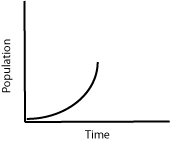
In the beginning the graph rises so slowly it appears almost horizontal. Then, over time, because space and food does not affect cell division, the slope changes to almost vertical. The change in slope results from the change in number of cells added each cycle. For example, during the 10th division about 500 cells are added to the population. During the 20th division 1000 times 500 cells are added.
Of course, there has to be space and food for all these cells. If the space gets filled or the nutrient flow can not support more cells, the population stops growing.
As the constraints of food and space begin to inhibit cell division, the curve changes from almost vertical back to almost horizontal. The population stops growing. New cells replace those that die.
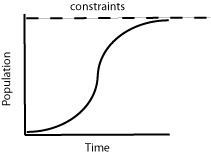
Given no predators, all biological species have this shape to their graph of population versus time.
Some species follow the curve more gracefully than others. For example if you plow an island and plant just a few seeds of grass, the first year will have just a few grass plants that grow to seed.
These seeds, blown away from the parent plants and finding bare soil, will grow into new plants. With plenty of new space available the population of grass plants grows more steeply each year.
However, when grass covers most of the soil, most seeds will never get to grow because existing plants prevent the seeds from finding soil where they can root. The seeds will rot and become part of the soil.
The seeds do not seem to scream in agony that they can not plant themselves and grow.
Introduce two rabbits
Next lets put a pair of rabbits on the island. They too will have babies and the babies will have babies. And as long as they have enough space to roam and grass to eat, the rabbit population grows and their population curve rises from flat to almost vertical.
At some point the suckling rabbit babies are weaned and they find the grass hard to find. Many of the new babies and the some of the older infirm rabbits will not find enough to eat and will die. The population continues to grow ever more slowly until a rabbit has to die for each new one to survive.
Rabbits do not seem to mind these harsh conditions. Parents of baby rabbits do not try to kill other rabbits to have food for their young. They can get along in this state indefinitely as long as they don't eat all the grass down to the roots, cause plant death, root rot, total soil erosion, and ecosystem destruction.
Introduce two mice
Before eco-destruction happens let's introduce two mice to the island. They eat grass or grass seeds. Maybe the seeds that would have rotted anyway. They follow the same population growth curve as the rabbits. They share the same food supply and thus the rabbits have a reduced food supply and their population falls to a new equilibrium.
The rabbits do not try and kill the mice. The mice are not consciously aware they are killing rabbits to establish the new equilibrium.
Introduce wolves
Now lets introduce wolves to the island. The wolf can eat rabbits or mice but not grass. They prefer rabbits. The wolf population can grow like any other biological species. As it gets bigger it eats all the rabbits.
The mice now can eat all the grass without competition and grow a larger population. The wolves start eating the mice.
Of course this time if the wolves eat too many mice there are not enough mice to feed all of the wolves.
Some wolves starve. Their population growth slows and then stops. The island has a balance of mice, wolves, and grass. When it does not rain, it's a bad year for everyone.
Introduce subsistence humans
Consider adding two humans to the island before the wolves eat all the rabbits. Let's make them hunters and gathers (HG's.) People living at subsistence. Humans reproduce slower than mice, rabbits, or wolves but they still reproduce faster than replacement and thus follow the same biological population curve.
The hunters and gathers migrate around the island and eventually eat wolves until they are extinct.
Then they migrate around and eat rabbits until they are extinct. Then they eat all the mice, leaving themselves a diet of grass.
If humans were like mice or rabbits their population would expand until each human was eating at subsistence. And each new stronger human being could exist only at the expiration of a weaker one, however, humans have some behaviors which delay or alter this outcome.
These hunter and gathers (HG's) can learn from experience and transmit it to their young. They can see the future before it happens. They can form groups to reserve part of the space and food supply for themselves. Each group attempts to drive off, kill, or enslave outside groups of humans that compete for the same resources. They can even eat their captives.
After one group kills off or eats all the others, it divides and the process repeats. Eventually all the humans will be eating grass or people.
Introduce NON-subsistence humans
Let's back up the clock to the point where we introduced HG's. Instead of HG's, lets introduce humans who live above subsistence (call them "not hunters and gatherers" NHG's.
When a NHG kills a wolf he or she may take only the skin and leave the meat. Then when he or she wants to eat they kill another wolf and leave the skin. Because of this practice, the wolf consumption of each NHG individual is bigger than the wolf consumption of each HG. Therefore the curve below does not directly follow growth in human population. Instead it represents consumption of wolves, which is the product of the number of people and the average number of wolves each consumes. The total number of wolves consumed is still constrained by the island's ability to produce wolves, which is still constrained by mice production, which is constrained by grass production.
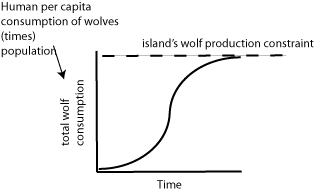
The island's wolf production will support a lower population of individuals living above subsistence than living at subsistence. How much lower is determined by how much the average person lives above subsistence. The figure below shows all the possible combinations of human population and per capita consumption of wolves that exist for the island's wolf production.
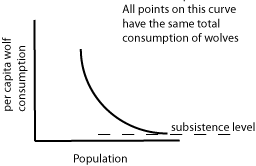
Moving along the curve to the left means lowering population and increasing per capita wolf consumption. Which means to continuously allowing increases in per capita consumption, deaths will have to continuously exceed births. This is accomplished either through killing, or producing children below replacement.
If they choose to have children below replacement, how much below replacement determines by how much the per capita consumption can increase. For example, assume there is a population of 5 humans and each consumes 4 wolves. Together they would consume a total of 20 wolves wolves per year.
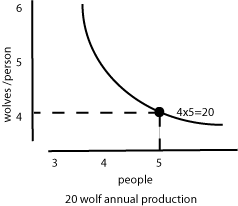
Since the wolves can produce 20 new wolves a year the system could continue forward for years without causing wolf extinction.
Then consider what happens if each person increases his or her consumption of wolves from 4 to 6. The 5 humans would then consume 30 wolves/yr. Far above replacement and the wolf population would decline to extinction.
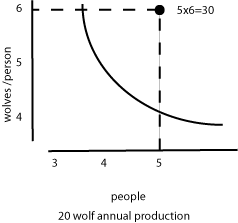
If the group reduced the human population to 4 , then they would consume a total of (4x6) or 24 wolves a year. This consumptive rate would still extinguish the wolf population.
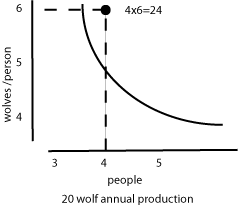
The human population must be reduced to 3. With three, the total wolves consumed would be 3 times 6 or 18.
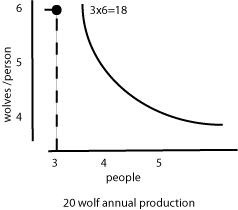
This would be below the annual wolf production and the wolf population would not go extinct.
Next let's consider the affects of technology which NHG's can create to raise the island's carrying capacity. They can grow more grass, if they can find an aquifer from which to pump water when it does not rain. If they can find and extract fossil fuels which can be converted into fertilizers or pesticides. If they can breed a better grass. In the future they might even find an energy source we have not discovered. The result is a larger wolf population and more available wolves each year.
However, on this island, the experience has been that technological advances have never expanded supplies of wolves faster than individuals can expand their consumption of them.
What lessons can we learn from this island analogy of our world?
1) Humans on earth have to give up the notion that
we can have
"biological growth."
2) We have to give up the notion of "biological
replacement."
3) We have to give up on "haphazard population
declines" as
a means for creating a nice future for
our grandchild."
4) We have to accept that: "The reduction in
consumption caused by
rapid population declines
MUST EXCEED the rise in consumption achieved
collectively by the remaining group."
These conclusions are supported by a graph containing four curves. These curves describe four variables that describe our world. The solid lines describe the values of these variables up to the present.
The dashed lines describe the Alpert alternative. (Variable values if everyone chooses to have "one-child-per- family.")
The BLACK curve shows the growth of HUMAN POPULATION. Up to the present, human population has followed a biological growth curve. If people all choose to have "one-child-per-family" the curve follows the dashed line.
The PURPLE curve shows the "PER CAPITA HUMAN FOOTPRINT." It increases for all of human history. As long as people want to improve their lives, this curve will continue to increase into the future.
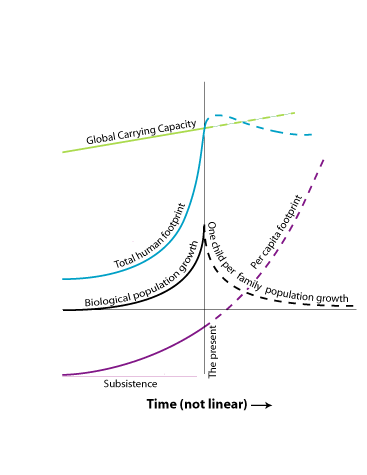
The BLUE curve "TOTAL HUMAN FOOTPRINT" is the product of the purple and black curve (Population times Per capita foot print.)
If we use subsistence equal to "1 unit" of footprint, then for the part of human history when almost all of the population was at subsistence, the total human burden on the environment was equal to the population.
This all changed when farmers began planting crops and storing grain. This made rises above "one" in per capita consumption possible. People, producing goods for food, could create wealth for the person with excess food. The purple curve could take values of ten's, hundred's and even thousands.
Lifestyles far above subsistence forced the "total footprint curve" to rise much faster than the population curve.
This went almost unnoticed by Malthus who was focused on biological population growth to predict the collision with carrying capacity.
Had he realized how fast per capita footprint could increase, he would have foreseen an earlier collision between human burden and carrying capacity - a condition we today still under appreciate.
The GREEN curve is the "GLOBAL CARRYING CAPACITY." It is a collection of interacting variables which determine how much can be produced to support life on earth.
Many have claimed that Malthus was wrong. There will be no collision between human burden and carrying capacity. Irrigation, fertilization, and crop genetics have, and future discoveries will, continue to increase carrying capacity.
However, Malthus may still be right for two reasons.
1) much of the water and fossil fuels supporting the elevated carrying
capacity are from non renewable sources. Without new water and energy
sources the gains may be temporary and the higher carrying capacity we
enjoy today could return to pre-green revolution values. The carrying
capacity could actually drop below previous natural levels due to soil
erosion, alternative land use, and poisoning of the natural resource base.
2) Even with existing elevations in carrying capacity, the total human footprint (the blue curve) has risen above the green curve. Ocean fish and forest trees are being consumed faster than their replacement. Carbon dioxide is being released into the atmosphere faster than it can be sequestered by plants.
Malthus never dreamed that humankind would be powerful enough to lower the carrying capacity. He predicted that population growth would be stopped by it - not destroy it.
Malthus' analysis also missed an additional problem, described by the "total footprint" and "carrying capacity" curves. Social stability depends on the "Total footprint" remaining far below "carrying capacity".
For all species, the approach of the "Total footprint" curve to the "carrying capacity" curve, creates scarcity. However, it is human intelligence that turns scarcity into stratification of wellbeing among the existing population. It is stratification, in an already constrained system, that results in a large portion of the population experiencing reduced wellbeing. It is the human intellect that converts reduced wellbeing into ever increasing social conflicts. These conflicts consume a bigger portion of the carrying capacity and cause another round of reduced wellbeing. It's a death spiral for the human community.
What actions would break this cycle of disenfranchisement and conflict? What actions would let people attain enough wellbeing to stop the conflict?
For example, what actions would allow those that have fallen behind in raising their wellbeing to rise to a western middle class lifestyle.
There are three avenues of action. Raise the carrying capacity, redistribute wealth, and reduce the population.
===1) Raising the carrying capacity has been done before - farming, industrialization, green revolution, information age, and genetically modified crops. However, increasing the carrying capacity is becoming harder because of depleted non renewables, over used renewables, and waste filled sinks. Historically these successes have not out paced increases in per capita footprint and thus have not reduced scarcity enough to prevent conflict.
===2) Reducing the footprint of some individuals, and transfer the resources to the bottom individuals in the community has also been tried and has not successfully diminished scarcity or conflict. The process worked marginally only when the total human footprint was far below the carrying capacity - a condition that does not exist today.
===3) Reducing the number of people runs counter to all biological and most cultural requirements. Let's investigate what population decline would be enough to achieve an adequate reduction in scarcity to inhibit conflict.
There are two parts to this solution.
1) Today the "have nots" consume 20% of the resources and
make up 80% of the population. Just allowing them to catch up to middle
class western life styles, without increasing the total human footprint,
would require a 75% reduction in global population.
2) A population reduction of 75% is not a goal. It's not even a mile stone. With each member of the world's population still working hard to increase his or her personal footprint, population decrease would have to continue at a very steep rate. Until individuals stopped striving for a better life, and effectively stopped increasing their footprint, declining population would have to remain a cornerstone of peaceful human existence.
The dotted lines in the graph depict implementation of the reduction in population alternative. They reflect a universal change in procreative behavior from greater-than-replacement to less-than-replacement. They reflect the extreme case where population halves every 30 years as a result of the universal selection of one child-per-family.
While the growth rate of per capital footprint is not affected by this behavior, the product of population and per capita footprint, the total human footprint, falls below the carrying capacity even when the per capita footprint doubles every 30 years. (Partly to a rising carrying capacity but mostly due to the economies of scale created in inheritance (a great grandchild, assuming ownership of all the residences of their 8 great grandparents, cannot utilize them to previous levels.
The most important consequence is that social conflict dissolves because with each individual's wellbeing increasing a factor of eight in a lifetime, the motivation to "make things get better faster by fighting" - dissolves.
One-child-per-family is a serious request to make of today's individuals. China has made it of its people and the world has condemn them for it. Asking the globe's 6 billion people to behave this way is even more difficult.
Each individual has his own reasons why he or she should not be asked to limit himself or herself to one child. "Only kids don't know how to share." "Let the guy who will have eight children have fewer kids." "Let the person on welfare have fewer kids." "I'll have fewer kids after I replace what my group lost in the last social injustice." If smart people have fewer kids, we will have only dumb people in the nation and they will vote to take what we have."
The justification for complying with this request is not simple. Yet it derives from the answer to the simple question framed in the first sentence of this paper." Is today's human condition different than it has been in the past."
The answer is a resounding "Yes."
Our relationship with our space and supporting resources is not like it used to be. We are no longer on the bottom half of a biological curve where constraints play little role in who consumes what. We are now on the top half of the curve where every expansion of population or individual footprint (not provided for by a technological efficiency) is a step downward in well being for some other person.
It is not the same because the total human footprint exceeds (or is too close to) the current carrying capacity.
Every day we remain over or near-to the carrying capacity, is degrading both our physical environment and our social fabric.
It is not the same because, we have always assumed that we could provide for ourselves and our children, "an ever advancing wellbeing" by rising to the top of our community, and now, this success, means we are the foremost target of the disenfranchised.
We are the target of the people we created, possibly unintentionally, by consuming the resources which could have prevented their slide in wellbeing.
Our success is now increasing our cost of living. We have to spend an ever bigger portion of our resources just to protect ourselves.
It appears the only way to accomplish everyone's original goal (and not have most of the world's population trying to kill each other) is for 6 billion people to rapidly and continuously decrease the global population.
We must all procreate below replacement. We must all limit ourselves to one child per family.
The sooner every one understands "the human condition is not like it used to be," the sooner we can stop killing each other. And the sooner we can be in the business of providing a constantly improving environment for our progeny.
